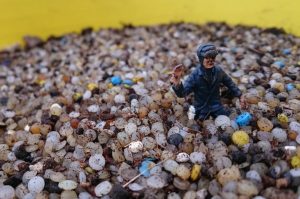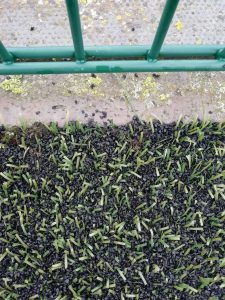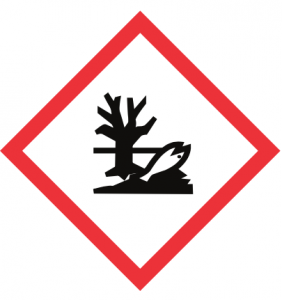Europe is now considering proposals to ban microplastic ingredients across a broad range of consumer products. But what does this mean for preventing pollution from plastic pellets and pitches? We take a look at the latest developments.
A microplastics restriction is within reach…
Back in 2019, the European Chemicals Agency (ECHA) began a long process to restrict microplastics ingredients intentionally added to products in Europe. This broad-reaching proposal not only includes microbeads, already banned in many countries worldwide including the UK, but also a range of products from detergents to toothpastes, sun creams to seed-coatings.

Perhaps for this reason, the process has taken a long time, with two expert committees and two public consultations closely scrutinising both the environmental risks of microplastics, and the potential social and economic impacts of banning each product. Now, finally, ECHA’s final opinion has been officially passed on to the European Commission, who will put together a proposal over the coming 3 months based on the detailed reports of ECHA, after which a period of negotiation begins with member states. If all goes to plan, the restriction is planned to come into force in 2022, but exactly what the final restriction will look like is still unclear.
There is still a lot to play for in the negotiations around this potential ban. The Rethink Plastic group of NGOs working in Brussels have put together a detailed position paper (80 pages long!) to explain exactly what still needs to improve to make this ban as effective as possible. Here we’ve picked out what this ban might mean for Fidra’s projects on preventing microplastic pollution.
The pitch for pitches – give microplastic the red card
Microplastic infill used on artificial pitches is being considered within the ECHA restriction, with two options on the cards:

Rubber crumb used on sports pitches is a type of microplastic. It is often made from ground up old tyres.
1) A ban on infill sold, 6 years after the restriction comes into force (I.e. no earlier than 2028)
2) Infill is not banned, but pitches will be required to put physical and management measures in place (similar to those in our guidelines) to reduce microplastic loss to no more than 7g/m2/ year. This requirement would enter into force by 2025 at the earliest.
ECHA’s opinion on this is split – the Risk Analysis Committee has clearly shown a preference for a ban, as the second option still leaves, on average, 50kg of microplastic leaving each pitch. That’s 1600 tonnes of microplastics still emitted each year across Europe. They also highlight how difficult it will be to enforce measures to reduce microplastic loss across all European pitches. The Committee for Socio-economic Analysis suggest that switching to alternatives might be a more expensive option, though they leave both options open, calling it a ‘political decision’.
We are clear on where we stand when faced with this choice: ban infill. Removing loose microplastic from the pitch and switching to alternative materials will always be more effective to stop pollution. This will also be far simpler for communities using pitches. Alternatives to plastic infill exist on the market and the long transition time will give the chance for their market share to build and costs to go down. Even now these infills are not necessarily more expensive than microplastics.
The pitch for pellets – ‘spill the beans’ on spills
The plastic pellets (or nurdles) used in plastic production have never been considered as part of the ban on microplastics, as they are (currently) an unavoidable part of production. However, ECHA do suggest that companies handling pellets should be required to report yearly on pellet losses and include instructions for use and disposal when pellets are sold.
Fidra see a potential solution to pellet pollution in the creation of a supply chain accreditation approach (pdf)based on standards and certification schemes. We join the call of NGOs to make this obligatory across Europe, meaning that any company handling pellets would require external audits to show they are handling pellets responsibly. This remains under discussion as the European Commission has recently announced a new study exploring a variety of voluntary and legislative options for pellets.

Pictograms such as this one are very effective in communicating environmental hazard. Image source
Reporting and instructions aren’t a substitute for this kind of legislation but they could help to support it if well-designed. However, this means improving on the current ECHA proposal:
- Companies should report more detail to create genuinely useful information. This includes tonnages handled and estimates of pellets lost based on real measurements.
- Labels should be up front and visible on packaging, warning that pellets are microplastics, with symbols highlighting environmental risk. These will be far more effective in reaching those handling pellets on the factory floor than instructions hidden away on product leaflets.
Next Steps
While the proposed microplastic restriction is a first step to preventing pollution, there are many more to go. These proposals must become legislation, and legislation needs to lead to positive change in practice. Despite the broad ban, there are microplastics not covered by these restrictions. In many ways, this is just the beginning. To keep up to date on the latest developments follow us on twitter.
Further Reading
- Briefing: How do we tackle plastic pollution from global pellet loss?(pdf)
- Our projects on tackling microplastic pollution from pitches and solutions to pellet pollution.
- Explore alternatives to plastic infill on pitches
- Blog: So long to rubber crumb? Our take on the proposal to restrict microplastic infill from sports pitches.
